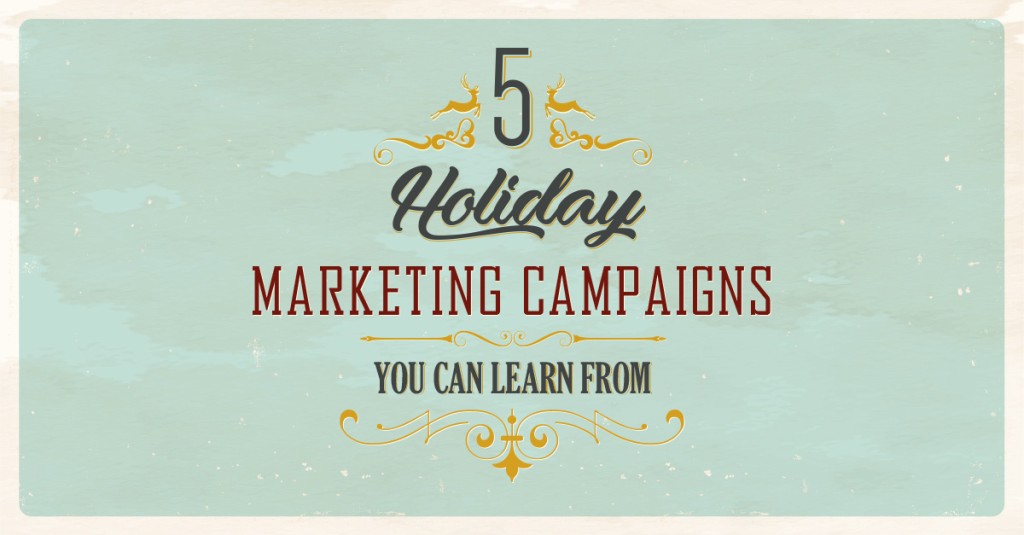What Marketers Can Learn From 5 Great Holiday Marketing Campaigns (And One Bad One)
Fourth quarter is shopping season. This year, the National Retail Federation predicts a 3.6 to 4.0% increase in sales, translating to a potential $682 billion. The strengthening economy has buyers making transactions in person, online, and through mobile apps as part of a distributed commerce experience.
Why are consumers and business buyers alike so tempted to buy this time of year? Some of the reasons are rational and need-based, but others are more emotional. The funny, nostalgic, and inspirational creative published by savvy marketers can serve as a pretty effective tipping point.
Here are 5 great holiday marketing campaigns, and what marketers can learn from them
1. McAfee Wants You to Protect What’s Under The Tree
When you think “holiday cheer,” your mind might not jump to cybersecurity. Yet given our adoption of connected devices and the IoT, concerns about personal information and data safety are very real.
Software company McAfee took a clever approach to remind holiday buyers to pick up more than just batteries or charge cords for those tablets, drones, and other connected devices. In the informational blog post “A Cybersecurity Carol: Key Takeaways from This Years’ Most Hackable Holiday Gifts,” security expert Gary Davis discusses ways electronics users can be more intentional when they open up electronic pathways.
The 2017 post is the second McAfee has published in as many years. In addition to presenting hard facts which could prompt audiences to purchase security protection (like 79 percent of consumers start using connected devices the day they receive them, although only 42 percent of those claim to take proper security measures when setting those devices up), the software company is far from dry with their approach.
Campaign executions: A well-designed infographic, website, GIF images, sweepstakes, clever videos, and #HackableToys themed hashtag bring a lot of weight to promote the campaign.
What McAfee did well: Cybersecurity isn’t top of mind for most. Add to that the sometimes-complex terminology and specialised knowledge, and our heads often get thrust in the sand. But denial is exactly how hackers gain opportunity. McAfee used humour and creativity to draw audiences into the issue and make them feel comfortable about taking proactive measures of precaution.
Takeaway: Brands can play reindeer games and still be taken seriously if they demonstrate real value to the end user. Instead of a taking a traditional, safe, or literal approach (which might just fade into background “noise”), try positioning your holiday-themed marketing in a way that demonstrates how your product or service resolves problems surfaced by the season
2. Coca-Cola Builds Excitement And Wonder
With its “Holidays Are Coming” commercial, beverage giant Coca-Cola successfully generates interest in its product (hanging lights is thirsty business) in the context of holiday preparations. The spot first aired 22 years ago, and is considered by many in the UK as the official kick-off to the holiday season.
The audio track of the video builds steadily, as a train might as it barrels through the countryside at night. The caravan of lighted commercial delivery trucks builds the viewers’ anticipation of Christmas morning. In the wake of the trucks, strands of colourful lights suddenly appear against the night sky to make the outdoors look beautiful and magical.
Campaign executions: Coca-Cola created a :30 television commercial as well as scheduled onsite visits of the grand truck lit by 8,722 lights to cities across the US and Europe, topped off with free beverage samples.
What Coca-Cola did well: Taste receptors send signals directly to the primitive brain, where memory resides. A spot like “Holidays Are Coming” cues up warm memories that may have included a refreshing, cold Coca-Cola. Visually attractive yet approachable, the ad has universal appeal.
Takeaways: It’s perfectly acceptable for a brand to play off nostalgia and and a sense of magic. By not taking the concept to the extreme, Coca-Cola walks a steady line of emotional, but believable, holiday marketing.
3. Apple Tugs At The Heartstrings… With A Twist
Over the years, Apple has released some compelling marketing (who can forget “Get a Mac”?). And even while the brand has legions of loyal advocates, the fact remains its products, along with those of other manufacturers of connected devices, are at the heart of a significant issue.
Teens spend an average of 9 hours a day on their devices, a 2015 census by Common Sense Media indicates. “...internet addiction is associated with structural and functional changes in brain regions involving emotional processing, executive attention, decision-making, and cognitive control…” cited Psychology Today in 2012, referring to multiple scientific studies. In light of the data, what’s an electronics company to do?
Well, bold brands like Apple embrace the controversy. In the 2013 “Holiday, Misunderstood” video, Apple used a seemingly withdrawn teen male character as a central focus. Like so many of us, he visits (maybe is thrust in the mix of) family for the holidays. Throughout the visit he appears fixated on his phone while life’s little moments go on around him.
The video peaks when the teen interrupts Christmas gift distribution to que up his phone with the television. Go take a look to see what he revealed to his family (using Apple AirPlay technology, of course).
Campaign executions: An Emmy award-winning 1:30 television commercial.
What Apple did well: In a single TV spot, Apple addressed a cultural issue surrounding technology use while also demonstrating the usefulness of its product (the iPhone 5s) and feature (AirPlay). The spot tells a very compelling and timely narrative.
Takeaways: Brands don’t have to pretend negativity surrounding their product or service doesn’t exist. Instead, key issues can be addressed in creative yet informative ways to put a positive spin on concerns.
4. Hershey’s Kisses Are A Tiny Package Of Holiday Joy
Music plays a big role in holiday festivities. The classic songs enjoyed for generations can tease out nostalgic memories and remind us of simpler times. In the :15 television commercial “Kisses,” Hershey’s used the song “We Wish You A Merry Christmas” in a fun, no-fuss way to promote sales of the tiny, colourful, individually wrapped chocolates.
Campaign executions: The Kisses TV spot has been aired virtually unchanged for decades. Currently the video is featured on the company YouTube channel and the Kisses product section on the website.
What Hershey’s did well: Hershey’s is no stranger to assigning its candy human-like qualities. “Kisses” depicts the tiny candies as a synchronised group of bell ringers, complete with one showing a little anxiety over its performance. In other television ad executions like “Easter,” seasonally-coloured wrapped candy interact in coordinated efforts together. This approach furthers the tone of accessible enjoyment often seen in Kisses marketing. And it’s worked, too. The ad has run continually each holiday since 1989.
Takeaway: While some candy brands use a platform of decadence in their marketing, the marketers at Hershey’s develop creative rooted in the brand characteristics. That’s key to maintaining believability, instead of trying to force a holiday tie-in.
5. NORAD Santa Tracker: Man Or Myth, We All Want To Believe
The NORAD Santa Tracker has humble beginnings. One retelling suggests the tale began in 1955 when Colonel Harry Shoup answered a critical command phone line to be greeted by a child’s voice asking, “Are you one of Santa’s helpers?” A misprint in a Sears newspaper ad had mistakenly directed children to call NORAD (then CONAD) with their holiday wishes.
As the story goes, Shoup used this opportunity to garner a public-relations boost for the military organization at a time when the nation was concerned about nuclear threats. He collaborated with his public relations officer to release statements to the media indicating NORAD was hard at work, using cutting-edge tracking technology to track Santa’s movements.
In the years since, the PR campaign has grown. What began as a Cold War PR tactic has matured into something more emotional and enduring. Families can catch a glimpse of military satellite and technology capabilities under the guise of keeping track of Kris Kringle’s arrival the eve of December 24.
Campaign executions: Following the jolly fellow’s preparations and journey couldn’t be easier. There’s the NORAD Tracks Santa website, YouTube channel, Facebook page, Twitter account, mobile app, and Instagram feed.
What NORAD did well: The PR folks at NORAD maximised an opportunity to lower some barriers between the military and general public by connecting a holiday and beloved icon with strategic defence technology. People may not be able to fully conceptualise NORAD’s technical capabilities, but the Tracks Santa campaign provides some context in a relevant, relatable way.
Takeaways: Almost any organization can reach new audiences if enough thought is put into identifying ways to be relevant to tertiary groups. Once those ways are found, consistent execution across myriad channels (as NORAD has employed) is the best way to gain momentum.
That’s All For The Nice. Cue The Naughty
Naughty is one way to describe “The Taste That Unites” video published by fast-food giant Kentucky Fried Chicken (KFC).
We appreciate a good try at humour. Sometimes, just to get through the stress of the countdown and gift expectations and financial woes, one has to have a healthy dose of humour. This 2:40 video by KFC shines a bright light on the holiday realities of shopping crowds, errant children flinging snow, and the pressures of visiting Santa in hopes of capturing the picture-perfect smile. But the layers of sarcasm and over-the-top theatrics in this video just add up to too much.
Campaign executions: Music video.
What KFC did wrong: KFC was attempting to relate to an audience that felt stressed-out and unenthusiastic about the holidays. The sourball humour on display may appeal to the grinchiest of grinches, but most of us enjoy the holidays even with the added stress. Instead of the end message being, “togetherness and celebration is worth the stress,” it ends up being, “eat fried chicken if you’re stressed. Or don’t, because it’s all a joke anyway, right? But eat KFC. WINK.” It’s a muddled message that loses any attempt at empathy with the audience.
Takeaways: Edginess and snark are so common in the marketing world that they’re losing effectiveness. Even the most acerbic message should contain a kernel of empathy and a dash of hope for the future — hope beyond, “maybe we can have some KFC after suffering through Christmas shopping.”
The holidays are a time of hope, peace, giving — and, yes, not a small portion of stress. Great holiday campaigns are driven by empathy for the audience, offering tidings of comfort and joy without dipping too deeply into sarcasm or syrupy-sweetness. That’s a blueprint for success that works through the holiday season, and throughout the rest of the year as well.
Related articles



